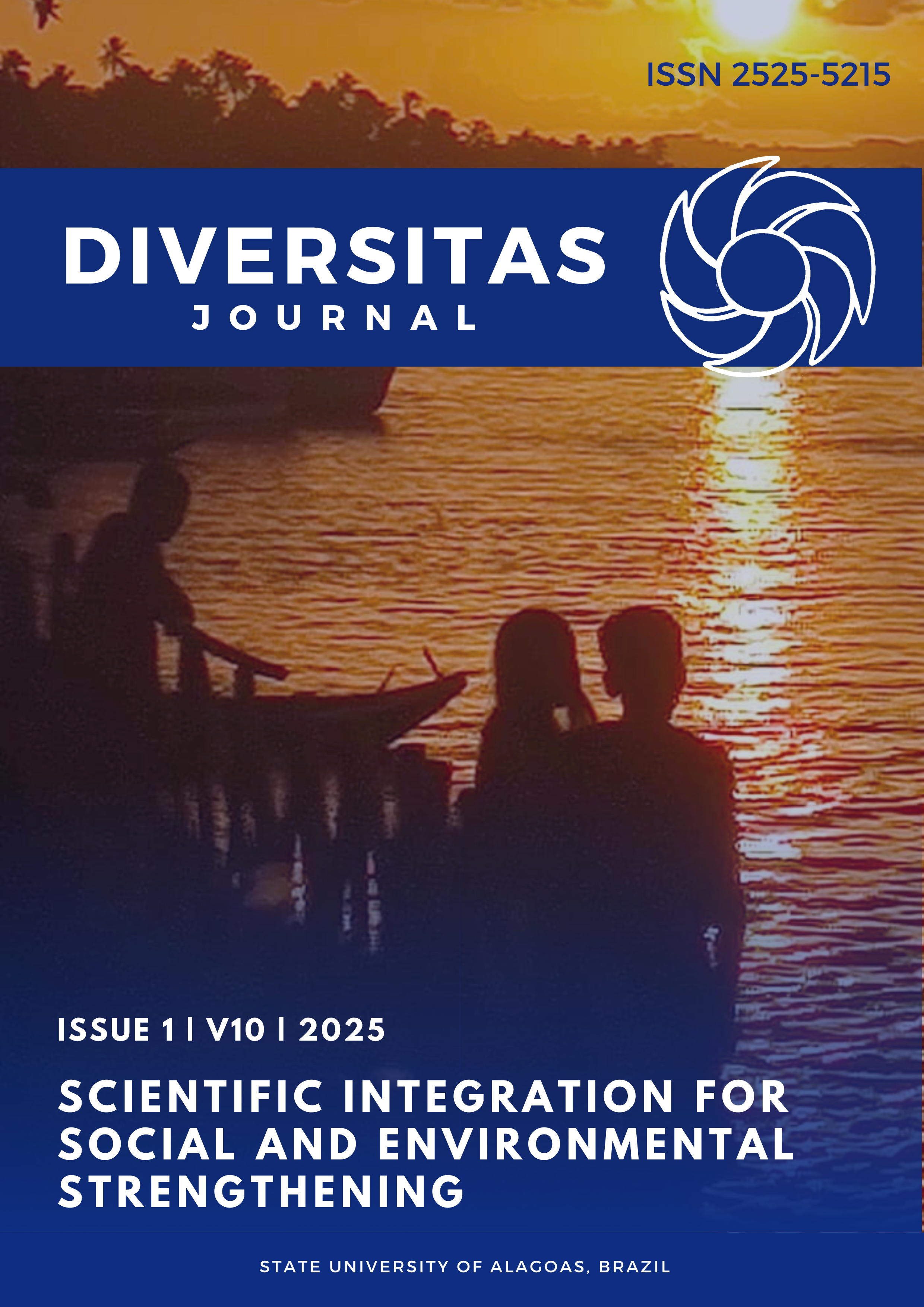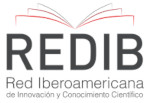Identification and characterization of glycosaminoglycans in fruit trees grown in Pernambuco
DOI:
https://doi.org/10.48017/dj.v10i1.2839Keywords:
Chemical compounds, Mucopolysaccharides , Microscopy, PhytochemistryAbstract
Glycosaminoglycans (GAGs) are found in plant and animal species and their use is increasingly common in the food, cosmetics and pharmaceutical industries. However, despite the studies that address the therapeutic power of plants, there are only studies that report the identification and characterization of GAGs in animals. In view of this, this study aimed to characterize and locate glycosaminoglycans in leaves of plant species cultivated in the state of Pernambuco. For this, histochemical characterizations and phytochemical prospection by colorimetric reactions and Thin Layer Chromatography of caju (Anacardium occidentale), fruta-pão (Artocarpus altilis), mangaba (Hancornia speciosa), acerola (Malpighia emarginata) and siriguela (Spondias purpurea) were carried out. . Through histochemical tests, phenolic compounds, starch, lipophilic compounds and lignins were observed in different species. It is noteworthy that the species that presented crystals, its composition based on calcium oxalate was observed. Regarding the specific histochemical tests for GAGs, mucilage, reducing sugar, acidic polysaccharides, pectins and neutral polysaccharides were observed. In the phytochemical tests, flavonoids, cinnamic derivatives and tannins were identified only in cashew and crabmeat. In the specific characterization for GAGs, the glucosamine standard obtained a low retention factor, while the glucose standard eluted satisfactorily. The data found provide an important contribution to the histochemical and phytochemical characterization of GAGs.
Metrics
References
Agra, M. F.; Silva, K. N.; Basílio, I. J. L. D.; Freitas, P. F.; Barbosa-Filho, J. M. (2008). Survey of medicinal plants used in the region Northeast of Brazil. Revista brasileira de farmacognosia, 18 (3), 472–508. https://doi.org/10.1590/S0102-695X2008000300023
Almeida, F. L. C.; Oliveira, E. N. A.; Almeida, E. C.; Souza, W. F. C.; Silva, M. O.; Melo, A. M.; Castro, M. P. J.; Bullo, G. T.; Luna, L. C.; Prata, A. S.; Forte, M. B. S. (2022). Hancornia speciosa: An overview focused on phytochemical properties, recent achievements, applications, and future perspectives. International Journal ofGastronomyand Food Science,29, 1-13. https://doi.org/10.1016/j.ijgfs.2022.100561
Baptista, A. B. Extrato de folhas de caju (Anacardiumoccidentale L.) e de cajuí (Anacardiummicrocarpum D.): Prospecção fitoquímica, atividade antioxidante, antimicrobiana e antiinflamatória, in vitro e in vivo. 2018. 100f. Universidade Federal de Viçosa, Viçosa, Minas Gerais, 2018.
Bukatsch, F. (1972). BemerkungenzurDoppelfarbung: Astrablau-Safranin. Mikrokosmos, 61 (8), 255.
Campos, E. P. C. F.; Santos, D. M.; Sá, R. D.; Randau, K. P. (2021). Microscopic Analysis Applied to the Quality Control of Hancornia speciosa Gomes. Microscopy and Microanalysis, 27 (5), 1–8. https://doi.org/10.1017/S1431927621012058
Chacko, C. M.; Estherlydia, D. (2014). Antimicrobial evaluation of jams made from indigenous fruit peels. InternationalJournalofAdvancedResearch, 2 (1), 202–207.
Chaves, S. M.; Panontin, J. F. (2019). Screening fitoquímico da folha e caule da Hancorniaspeciosa gomes(mangabeira) com finalidade de bioprospecção cosmética. In. XIX Jornada de Iniciação Científica.
Costa, A. J.; Araújo, M. R. S.; Dias, B.; Feitosa, C. M.; Santos, R. P.; Ferreira, D. A.; Araújo, F. P. S. (2019). Estudo químico e farmacológico de Artocarpusaltilis (Parkinson) Fosberg. In. Ribeiro, j. c.; Santos, c. a. (Org). As ciências exatas e da terra no século XXI [recurso eletrônico]. v. 2. Ponta Grossa, PR: Atena Editora.
Feder, N.; O’Brien, T. P. (1968). Plant microtechinique: some principlesand new methods. Amer. J. Bot., 55, 123-142. https://doi.org/10.2307/2440500
Federação das Doenças Raras de Portugal (Brasil). (2013). Doenças Raras de A a Z. São Paulo: Outbox Interativa, 216 p.
Fernandes, E. F. O.; Maciel, I. G. S.; Silva, N. C. M.; Anjos, H. A. (2021). Avaliação da composição de nutricosméticos utilizados no tratamento de cabelo. Interfaces Científicas -Saúde e Ambiente, 8 (3), 385–398. https://doi.org/10.17564/2316-3798.2021v8n3p385-398
Figueiredo, E. S. Macedo, A. C.; Figueirêdo, P. F. R.; Figueirêdo, R. S. (2010). Aplicações oftalmológicas do ácido hialurônico. Arq. Bras. Oftalmol., 73 (1), 92-95. https://doi.org/10.1590/S0004-27492010000100018
Figueiredo, A. C. S.; Barroso, J. M. G.; Gaspar Pedro, L. M.; Ascensão, L. (2007). Histoquímica e citoquímica em plantas: princípios e protocolos. 1 ed. Lisboa: Repro2000, 80p.
Guillaumie, F.; Malle, B. M.; Schwach-Abdellaoui, K.; Beck, T. C. (2006). A New Sodium Hyaluronate for Skin Moisturization and Antiaging. Cosmetics & Toiletries, 121, 51-58.
Humbel, R.; Chamoles, N. A. (1972). Sequential thin layer chromatography of urinary acidic glycosaminoglycans. Clin Chim Acta, 40, 290-293. https://doi.org/10.1016/0009-8981(72)90287-2
Jensen, W.A. (1962). Botanical Histochemistry (principles and practice). San Francisco: W. H. Freeman and Company.
Johansen, D. (1940). Plant microtechnique. New York: Mcgraw-Hill Book, 523 p.
Khandare, A. L.; Kumar, P. U.; Lakshmaiah, N. (2000). Beneficial effect of tamarind ingestion of fluoride toxicity in dogs. Fluoride, 33 (1), 33–38.
Korwar, P. G.; Beknal, A. K.; Patil, B. S.; Halkai, M. A.; Kulkarni, U.; Hariprasanna, R. C.; Soodam, S. R. (2010). A study on phytochemical investigation of Drynaria quercifoliaLinn rhizome. InternationalJournalof Pharmaceutical Science andResearch, 1, 148-158. http://dx.doi.org/10.13040/IJPSR.0975-8232.1(12).148-58
Lipiello, L.; Mankin, H. J. (1971). Thin-layer chromatographic separation of theisomeric chondroitin sulfates, dermatan sulfate, and keratan sulfate. AnalyticalBiochemistry, 39, 54-58. https://doi.org/10.1016/0003-2697(71)90460-x
Mace, M. E.; Howell, C. R. (1974). Histochemistry and identification of condensed tannin precursor in roots os cotton seedlings. Canadian JournalofBotany, 52, 2423-2426. https://doi.org/10.1139/b74-314
Mace, M. E.; Bell, A. A.; Stipanovic, R. D. (1974). Histochemistry and isolation of gossypol and related terpenoids in roots of cotton seedlings. Phytopathology, 64, 1297-1302.
McManus, J. F. A. (1948). Histological and histochemical uses of periodic acid. Stain Technol., 23, 99-108. https://doi.org/10.3109/10520294809106232
Miller, A.; Schaal, B. (2005). Domestication of a Mesoamerican cultivated fruit tree, Spondias purpurea. ProceedingsoftheNationalAcademyofSciencesofthe United States ofAmerica, 102 (36), 12801–12806. https://doi.org/10.1073/pnas.0505447102
Moura, A. L.; Guimarães, B. M.; Lima, J. A. C.; Mata, M. M. S.; Silva, J. F.; Oliveira, R. N.; Freitas, J. C. R.; Freitas Filho, J. R. (2019). Avanços Recentes Na Química Dos Aminoaçúcares: ocorrência, biossíntese, síntese e aplicação.Química Nova, 42 (6), 1-19.
Nascimento, M. H. M.; Lombello, C. B. (2016). Hidrogéis a base de ácido hialurônico e quitosana para engenharia de tecido cartilaginoso. Polímeros, 26 (4), 360-370. https://doi.org/10.1590/0104-1428.1987
Nolasco, N. L.; Santos, M. M. O.; Costa, R. O.; Santos, A. P.;. Rezende, L. C.; Sousa, V. R. (2016). Análise fitoquímica das folhas de Spondiaspurpurea L. (Seriguela). In. 39 a Reunião Anual da Sociedade Brasileira de Química: Criar e Empreender.
Palupi, D. H. S.; Retnoningrum, D. S.; Iwo, M. I.; Soemardji, A. A. (2020). Leaf extract of Artocarpus altilis [Park.] Fosberg has potency as antiinflammatory, antioxidant, and immunosuppressant. Rasayan Journal Of Chemistry, 13 (01), 636-646. http://dx.doi.org/10.31788/RJC.2020.1315519
Pearse, A. G. E. (1980). Histochemistry: Theoreticalandapplied. 4 ed. LongmanGroupLimited.
Pernambuco, G1 (ed.). Puxada por cana e frutas, produção agrícola de Pernambuco tem maior aumento em 45 anos, diz IBGE. 2020. Disponível em: https://g1.globo.com/pe/pernambuco/noticia/2020/10/01/puxada-por-cana-e-frutas-producao-agricola-de-pernambuco-tem-maior-aumento-em-45-anos-diz-ibge.ghtml#:~:text=Em%202019%2C%20a%20produ%C3%A7%C3%A3o%20agr%C3%ADcola,Geografia%20e%20Estat%C3%ADstica%20(IBGE). Acessoem: 31 mar. 2021.
Pierre, A. (2004). Hyaluronic acid and its use as a “rejuvenation” agent in cosmetic dermatology. Semin Cutan Med Surg., 23, 218-222. https://doi.org/10.1016/j.sder.2004.09.002
Pegorin, G. S.: Leite, M. N.; Antoniassi, M.;Chagas, A. L. D.; Santana, L. A.; Garms, B. C.; Marcelino, M. Y.; Herculano, R. D.; Cipriani Frade, M. A. (2020). Physico‐chemical characterization and tissue healing changes by Hancornia speciosa Gomes látexbiomembrane. Journal Of Biomedical Materials Research Part B: Applied Biomaterials, 109 (7), 938-948. https://doi.org/10.1002/jbm.b.34758
Reis, A. L. L. E.; Silva, D. S.; Silva, K. L. F.; Chagas, D. B. (2014). Caracterização anatômica e histoquímica de raízes e folhas de plântulas de Anacardiumoccidentale L. (Anacardiaceae). Revista Árvore, 38 (2), 209-219. https://doi.org/10.1590/S0100-67622014000200001
Righetto, A. M.; Netto, F. M. Carraro, F. (2005). Chemical composition and antioxidant activity of juices from mature and immature acerola (Malpighia emarginata DC). Food Science and Technology International, 11 (4). https://doi.org/10.1177/1082013205056785
Santos, G. D. M.; Magalhães, C. S.; Sá, R. D.; Randau, K. P. (2021). Anatomical and histochemical characterization of leaves of Spondias purpurea L. Journal of Environmental Analysis and Progress, 6 (3), 268-277. https://doi.org/10.24221/jeap.6.3.2021.3969.268-277
Sá, R. D.; Cadena, M. B.; Padilha, R. J. R.; Alves, L. C.; Randau, K. P. (2019). Comparative anatomy and histochemistry of the leaf blade of two species of Artocarpus. Anais da Academia Brasileira de Ciências, 91 (1), 1-10. http://dx.doi.org/10.1590/0001-3765201820170922
Sass, J. E. (1951).Botanicalmicrotechnique. 2. ed. Ames: The Iowa StateCollege Press, p. 391.
Scott. J. E. (1992). Supramolecular organization of extracellular matrix glycosaminoglycans, in vitro and in the tissues. FASEB J, 6 (9), 2639-2645.
Silva, M. R.; Lacerda, D. B. C. L.; Santos, G. G. S.; Martins, D. M. O. (2008). Caracterização química de frutos nativos do cerrado. Ciência Rural, 38 (6), 1790-1793. https://doi.org/10.1590/S0103-84782008000600051
Souza, J. F.; Santana, E. A.; Silva, A. S. S.; Souza, A. C. F. (2023). Avaliação físico-química de acerola, Malpighiaemarginata DC., proveniente de Macapá-Amapá. Journal of Biology & Pharmacy and Agricultural Management, 16 (2), 156-176.
Suryawanshi, J. A. S. (2011). An overview of Citrus aurantium used in treatment of various diseases. African Journalof Plant Science, 5 (7), 390–395.
Tezel, A.; Fredrickson, G. H. (2008). The science of hyaluronic acid dermal fillers. J Cosmetic Laser Therapy, 10, 35-42. https://doi.org/10.1080/14764170701774901
Tölke, E.D; Laccia, A. P. S.; Lima, E. A.; Demarco, D.; Ascensão, L.; Carmello-Guerreiro, S. M. (2021). Secretory ducts in Anacardiaceae revisited: Updated concepts and new findings based on histochemical evidence. South African JournalofBotany, 138, 394-405. https://doi.org/10.1016/j.sajb.2021.01.012
Ventrela, M.C. Almeida, A. L.; Nery, L. A.; Coelho, V. P. M. (2013). Métodos histoquímicos aplicados às sementes. Viçosa, Minas Gerais: ePUB.
Yoder, L. R.; Mahlberg, P. G. (1976). Reactions of alkaloid and histochemical indicators in laticifers and specialized parenchyma cells of Catharanthus roseus (Apocynaceae). American JournalofBotany, 63, 1167-1173. https://doi.org/10.2307/2441734
Downloads
Published
How to Cite
Issue
Section
License
Copyright (c) 2025 Lucas de Oliveira Nunes, Manoel Henrique Fernandes Soares, Felipe Ribeiro da Silva, Herlayne Carolayne Caetano da Silva, Cledson dos Santos Magalhães, Karina Perrelli Randau

This work is licensed under a Creative Commons Attribution 4.0 International License.
The Diversitas Journal expresses that the articles are the sole responsibility of the Authors, who are familiar with Brazilian and international legislation.
Articles are peer-reviewed and care should be taken to warn of the possible incidence of plagiarism. However, plagiarism is an indisputable action by the authors.
The violation of copyright is a crime, provided for in article 184 of the Brazilian Penal Code: “Art. 184 Violating copyright and related rights: Penalty - detention, from 3 (three) months to 1 (one) year, or fine. § 1 If the violation consists of total or partial reproduction, for the purpose of direct or indirect profit, by any means or process, of intellectual work, interpretation, performance or phonogram, without the express authorization of the author, the performer, the producer , as the case may be, or whoever represents them: Penalty - imprisonment, from 2 (two) to 4 (four) years, and a fine. ”


















